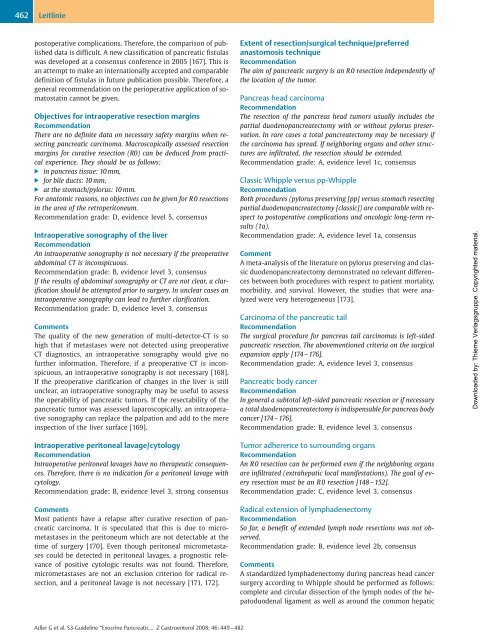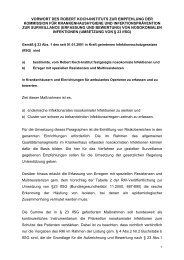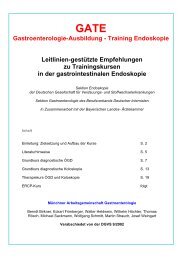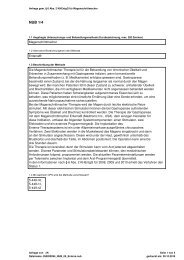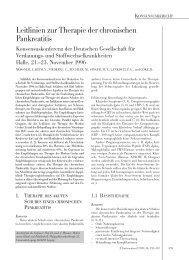S3-Guideline “Exocrine Pancreatic Carcinoma” 20071 ... - DGVS
S3-Guideline “Exocrine Pancreatic Carcinoma” 20071 ... - DGVS
S3-Guideline “Exocrine Pancreatic Carcinoma” 20071 ... - DGVS
Create successful ePaper yourself
Turn your PDF publications into a flip-book with our unique Google optimized e-Paper software.
462<br />
Leitlinie<br />
postoperative complications. Therefore, the comparison of published<br />
data is difficult. A new classification of pancreatic fistulas<br />
was developed at a consensus conference in 2005 [167]. This is<br />
an attempt to make an internationally accepted and comparable<br />
definition of fistulas in future publication possible. Therefore, a<br />
general recommendation on the perioperative application of somatostatin<br />
cannot be given.<br />
Objectives for intraoperative resection margins<br />
Recommendation<br />
There are no definite data on necessary safety margins when resecting<br />
pancreatic carcinoma. Macroscopically assessed resection<br />
margins for curative resection (R0) can be deduced from practical<br />
experience. They should be as follows:<br />
E in pancreas tissue: 10 mm,<br />
E for bile ducts: 10 mm,<br />
E at the stomach/pylorus: 10 mm.<br />
For anatomic reasons, no objectives can be given for R 0 resections<br />
in the area of the retroperitoneum.<br />
Recommendation grade: D, evidence level 5, consensus<br />
Intraoperative sonography of the liver<br />
Recommendation<br />
An intraoperative sonography is not necessary if the preoperative<br />
abdominal CT is inconspicuous.<br />
Recommendation grade: B, evidence level 3, consensus<br />
If the results of abdominal sonography or CT are not clear, a clarification<br />
should be attempted prior to surgery. In unclear cases an<br />
intraoperative sonography can lead to further clarification.<br />
Recommendation grade: D, evidence level 3, consensus<br />
Comments<br />
The quality of the new generation of multi-detector-CT is so<br />
high that if metastases were not detected using preoperative<br />
CT diagnostics, an intraoperative sonography would give no<br />
further information. Therefore, if a preoperative CT is inconspicuous,<br />
an intraoperative sonography is not necessary [168].<br />
If the preoperative clarification of changes in the liver is still<br />
unclear, an intraoperative sonography may be useful to assess<br />
the operability of pancreatic tumors. If the resectability of the<br />
pancreatic tumor was assessed laparoscopically, an intraoperative<br />
sonography can replace the palpation and add to the mere<br />
inspection of the liver surface [169].<br />
Intraoperative peritoneal lavage/cytology<br />
Recommendation<br />
Intraoperative peritoneal lavages have no therapeutic consequences.<br />
Therefore, there is no indication for a peritoneal lavage with<br />
cytology.<br />
Recommendation grade: B, evidence level 3, strong consensus<br />
Comments<br />
Most patients have a relapse after curative resection of pancreatic<br />
carcinoma. It is speculated that this is due to micrometastases<br />
in the peritoneum which are not detectable at the<br />
time of surgery [170]. Even though peritoneal micrometastases<br />
could be detected in peritoneal lavages, a prognostic relevance<br />
of positive cytologic results was not found. Therefore,<br />
micrometastases are not an exclusion criterion for radical resection,<br />
and a peritoneal lavage is not necessary [171, 172].<br />
Adler G et al. <strong>S3</strong>-<strong>Guideline</strong> <strong>“Exocrine</strong> <strong>Pancreatic</strong>… Z Gastroenterol 2008; 46: 449–482<br />
Extent of resection/surgical technique/preferred<br />
anastomosis technique<br />
Recommendation<br />
The aim of pancreatic surgery is an R0 resection independently of<br />
the location of the tumor.<br />
Pancreas head carcinoma<br />
Recommendation<br />
The resection of the pancreas head tumors usually includes the<br />
partial duodenopancreatectomy with or without pylorus preservation.<br />
In rare cases a total pancreatectomy may be necessary if<br />
the carcinoma has spread. If neighboring organs and other structures<br />
are infiltrated, the resection should be extended.<br />
Recommendation grade: A, evidence level 1c, consensus<br />
Classic Whipple versus pp-Whipple<br />
Recommendation<br />
Both procedures (pylorus preserving [pp] versus stomach resecting<br />
partial duodenopancreatectomy [classic]) are comparable with respect<br />
to postoperative complications and oncologic long-term results<br />
(1a).<br />
Recommendation grade: A, evidence level 1a, consensus<br />
Comment<br />
A meta-analysis of the literature on pylorus preserving and classic<br />
duodenopancreatectomy demonstrated no relevant differences<br />
between both procedures with respect to patient mortality,<br />
morbidity, and survival. However, the studies that were analyzed<br />
were very heterogeneous [173].<br />
Carcinoma of the pancreatic tail<br />
Recommendation<br />
The surgical procedure for pancreas tail carcinomas is left-sided<br />
pancreatic resection. The abovementioned criteria on the surgical<br />
expansion apply [174 –176].<br />
Recommendation grade: A, evidence level 3, consensus<br />
<strong>Pancreatic</strong> body cancer<br />
Recommendation<br />
In general a subtotal left-sided pancreatic resection or if necessary<br />
a total duodenopancreatectomy is indispensable for pancreas body<br />
cancer [174–176].<br />
Recommendation grade: B, evidence level 3, consensus<br />
Tumor adherence to surrounding organs<br />
Recommendation<br />
An R0 resection can be performed even if the neighboring organs<br />
are infiltrated (extrahepatic local manifestations). The goal of every<br />
resection must be an R0 resection [148–152].<br />
Recommendation grade: C, evidence level 3, consensus<br />
Radical extension of lymphadenectomy<br />
Recommendation<br />
So far, a benefit of extended lymph node resections was not observed.<br />
Recommendation grade: B, evidence level 2b, consensus<br />
Comments<br />
A standardized lymphadenectomy during pancreas head cancer<br />
surgery according to Whipple should be performed as follows:<br />
complete and circular dissection of the lymph nodes of the hepatoduodenal<br />
ligament as well as around the common hepatic<br />
Downloaded by: Thieme Verlagsgruppe. Copyrighted material.


